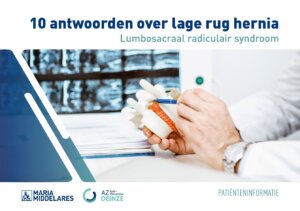Lower back hernia: ten questions answered
What is it?
What is it?The spinal column consists of stacked vertebrae. There is an elastic, shock-absorbing intervertebral disc in-between the vertebrae. They allow the vertebrae to move against each other. The spinal canal contains the spinal cord and runs vertically through the intervertebral discs. The spinal cord branches out in nerve roots that are between every two vertebrae. These nerve roots enter the body, and, as such, are quite close to the intervertebral discs.
A disc hernia is a protrusion of the intervertebral disc, caused by the decrease in the fluid contents and the elasticity of the intervertebral disc. Such a protrusion in the lower back can cause inflammation and/or place pressure on one or more nerve roots, and this causes pain.
Process
ProcessTest
Of these patients, 75% recover spontaneously within three months. That is why conservative treatment, using pain medication, anti-inflammatories and movement, is preferable. If the leg pain subsides spontaneously, or it is not too severe, you may try physical therapy. If the radiating pain significantly improves after six to eight weeks, it is reasonable to continue with conservative treatment.
If the leg pain is severe, or if the pain medication is not helping sufficiently, an epidural injection with corticosteroids (Cortisone) may help reduce the pain more quickly. An injection of this sort is most effective in the first couple of months.
For persistent pain, or if your symptoms have not sufficiently subsided after approximately twelve weeks, a surgery to remove the protrusion may be considered. In the short run, surgery will resolve the leg pain and allow you to regain muscle strength more quickly. In the long run, however, surgery does not guarantee better results than continued observation, pain medication and physical therapy. You might also experience problems with reduced muscle strength or numbness after the surgery.
Leaflet
LeafletSee the leaflet below for more information about:
- the possible side effects and complications
- practical information

Meer weten over lage rug hernia
DownloadCentres and specialist areas
Centres and specialist areas
Latest publication date: 16/05/2024
Supervising author: Dr Decaigny Veronique



